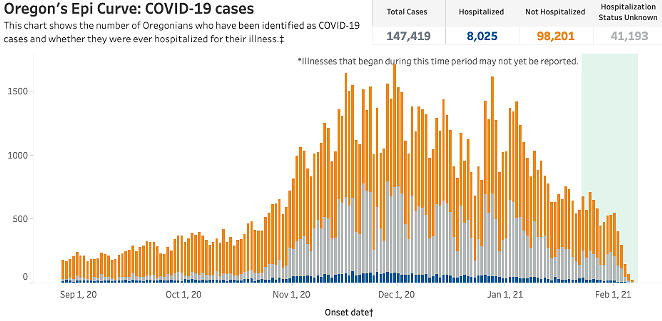Counties moving from Extreme to High risk include Clackamas, Clatsop, Columbia, Deschutes, Hood River, Klamath, Linn, Multnomah and Washington counties, with Morrow County moving from Extreme to Moderate Risk.
tweet this
The state's public health framework puts counties in one of four categories, based on case counts and test-positivity rates, including Extreme Risk, High Risk, Moderate Risk and Lower Risk. Starting Feb. 12, 14 counties will remain in Extreme Risk, which prohibits indoor dining and places other tight restrictions on businesses and activities. Eleven counties will be at High Risk starting Feb. 12, with three at Moderate Risk and eight at Lower Risk.
Counties moving from Extreme to High risk include Clackamas, Clatsop, Columbia, Deschutes, Hood River, Klamath, Linn, Multnomah and Washington counties, with Morrow County moving from Extreme to Moderate Risk. Among the counties remaining in Extreme Risk are Central Oregon's less-populated counties, Crook and Jefferson.

Following Tuesday's announcement, the Oregon Restaurant & Lodging Association, which has been a critic of Brown's strict closure restrictions, released a statement.
According to ORLA, opening and closing restaurant operations has been identified as the biggest challenge facing the industry. The biggest headaches, ORLA stated, have centered around scheduling workers and determining how much food each restaurant would need in the midst of changing guidelines.
Dropping case numbers
Case numbers in the state have been dropping significantly in recent weeks. In Deschutes County, Tuesday’s daily new case count was a total of five. Compare that to the dozens of new daily cases in the county reported throughout December and January, and it’s clear that the advent of the COVID-19 vaccines is having an effect. For example, January 10’s daily case count was 51; December 10’s daily case count was 47.
“This week, first-dose vaccine appointments will be scheduled through primary care clinics that received allotments of first dose vaccine,” Deschutes County officials announced February 9. “Primary care clinics receiving vaccine will contact patients to schedule appointments. Some St. Charles patients and community members who are receiving second doses of the vaccine will be scheduled to receive their dose at the Deschutes County Fair & Expo Center.
“Pending availability, people age 80 and older who have completed the Central Oregon Vaccination Interest Form at vaccine.deschutes.org may be contacted to schedule an appointment. Those in Phase 1a and Phase 1b, Group 1 who have not yet received a first dose may also be scheduled at the Deschutes County Fair & Expo Center.”
This story may be updated.

























